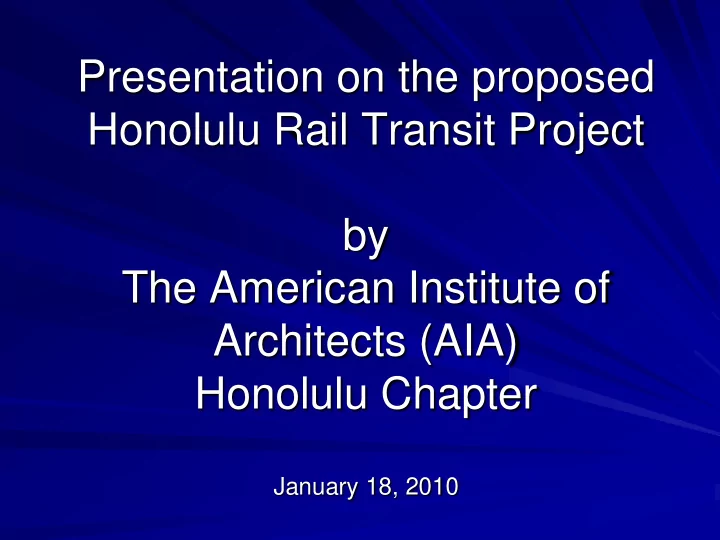

Presentation on the proposed Honolulu Rail Transit Project by The American Institute of Architects (AIA) Honolulu Chapter January 18, 2010
Why / Why Not?
The view today Nimitz Highway, looking Diamond Head
Why? Nimitz Highway, showing proposed elevated Chinatown Station Cost: approx. $270 million/ mile
Why not? Hotel Street showing at-grade Light Rail Transit Cost: approx. $70 million / mile
The view today King Street at University Avenue, looking mauka
Why? King Street at University Ave., showing proposed elevated rail and station (Phase 2) Cost: $270 million / mile
Why not? King Street at University Ave., showing at-grade Light Rail Transit option Cost: approx. $70 million/ mile
Why? Miami Elevated Rail Guideway (The only other urban all-elevated rail system in North America)
Why? Miami Elevated Rail Guideway - showing effects of tropical climate (mold) on concrete structures
Why? Miami elevated rail guideway and station, showing the effect at street level
Why not? Street-level Light Rail Transit with low-floor cars and platform station (Houston)
Why not? Street-level Light Rail Transit with Wireless Power Technology (when overhead wire is visually unacceptable) (Bordeaux, France)
Light Rail and Accessibility For elderly and/or disabled For children For bicycles
Light Rail… …is an electric railway using proven technology …is versatile and flexible enough to run at street level, on elevated structures, or through tunnels, in exclusive right-of- way …can have varied train lengths …can expand with increasing demand
We have this now… Why? Why not?
Environmental Impacts: Visual Impacts Noise Street Trees Iwi Safety & Security Rainwater Runoff Urban Environment
Elevated Rail in Waikiki (Phase 2) (Kuhio Ave.)
Adverse Impact on Street of Elevated Rail (Chicago)
Why? Nimitz Highway, showing proposed elevated Chinatown Station Cost: approx. $270 million/ mile
Noise Impact on Existing Residential Buildings (Elevated Guideway at Cooke & Halekauwila Sts.)
Noise Impact (Miami)
Impact on Existing Street Trees (Elevated Guideway at Dillingham Blvd.)
Light Rail – Minimal Impact on Street Trees (Barcelona)
Light Rail Track Detail – Minimal Excavation Required
Light Rail - New Track Construction (Portland)
Wireless Light Rail – New Construction (Bordeaux)
City’s Proposed Elevated Rail Stations for Honolulu “Football Fields in the Sky”
This is the reality – Mezzanine Access to Street (Miami)
Elevated Rail Stations Require Security Guards for Safety (Miami)
Street-level Light Rail – Security is Built-in (Portland)
Safety & Security Measuring Number of "Incidents" from 1998-2007 Source: US DOT Federal Transportation Administration Year 1998 1999 2000 2001 2002 2003 2004 2005 2006 2007 Automated Guideway Incidents 16 20 17 36 23 33 19 6 12 21 Passenger Miles (000) 7,010 5,002 6,424 8,503 8,254 8,430 9,499 11,646 11,687 12,639 Incidents/Passenger Mile 0.0000023 0.0000040 0.0000026 0.0000042 0.0000028 0.0000039 0.0000020 0.0000005 0.0000010 0.0000017 Passenger Miles/Incident 438,125 250,100 377,882 236,194 358,870 255,455 499,947 1,941,000 973,917 601,857 Light Rail Incidents 1,121 1,182 1,319 1,299 1,105 983 931 1,130 1,138 1,190 Passenger Miles (000) 1,115,351 1,190,168 1,338,782 1,409,821 1,420,117 1,462,494 1,553,378 1,650,509 1,806,248 1,858,045 Incidents/Passenger Mile 0.0000010 0.0000010 0.0000010 0.0000009 0.0000008 0.0000007 0.0000006 0.0000007 0.0000006 0.0000006 Passenger Miles/Incident 994,961 1,006,910 1,014,998 1,085,313 1,285,174 1,487,786 1,668,505 1,460,627 1,587,213 1,561,382 Ratio of LR to AG Passenger Miles/Incident 2.27 4.03 2.69 4.59 3.58 5.82 3.34 0.75 1.63 2.59 Note: (1) "Incident" defined to include collisions, derailment, personal casualty (injury or death), fire, and property damage (greater than $1,000as of 2003) (2) Passenger Miles are shown in thousands (000). (3) Ratio of Light Rail to Automated Guideway shows ratio of passenger miles travelled per incident. For example, in 1998 a passenger on Light Rail could travel 227% more miles before incurring an incident compared to travelling on Automated Guideway. OVER A 10-YEAR PERIOD 3.129 TIMES MORE SAFETY INCIDENTS PER PASSENGER MILE OCCURRED NATIONALLY ON AUTOMATED GUIDEWAYS THAN ON LIGHT RAIL
Safety & Security Platform Screen Doors Contrary to internationally accepted recommendations by UITP, Honolulu’s Elevated Rail system does not call for Platform Screen Doors. Platform Screen Doors are a critical safety component for automated rail, but are not included in the City’s project cost.
Elevated Rail = More Concrete At Street Level (Miami)
Grass Track Option for Street Level Light Rail Paris Barcelona
Existing urban environment (Hotel Street Mall)
Street-level Light Rail Is Compatible with Urban Fabric and Transit-Oriented Development
Street-level Light Rail is better for the neighborhood (Portland)
Recommend
More recommend